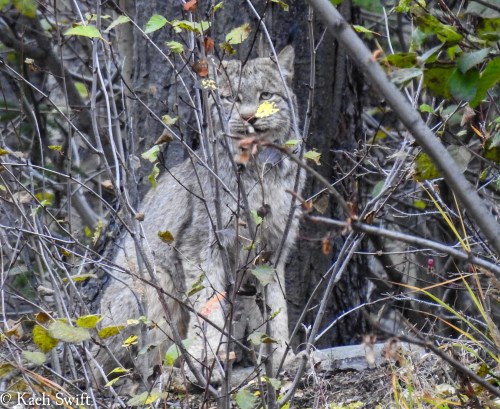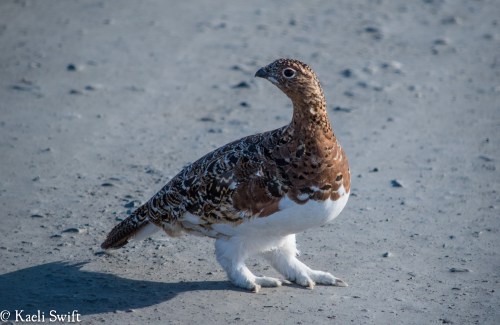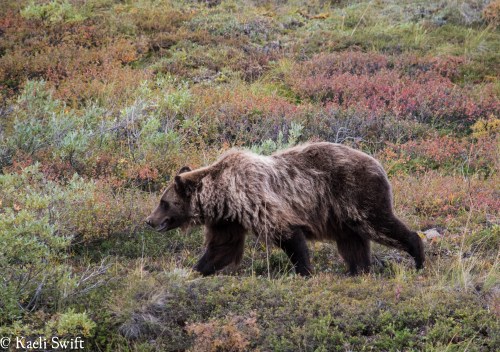One of my followers on Instagram recently requested a list of all the wildlife I’ve seen in the park. Since my stay has (for now) come to and end, it’s actually a great opportunity to look back on everything I’ve enjoyed while I’ve been here. Which animal would you most want to see? Let me know in the comments!
Mammals
1. Voles. Unfortunately this is only animal I neither have photos of nor can ID to species. When you see a vole the sighting usually goes something like this “look there’s a v-” and then it’s gone. Not much time to even wrap your head around it, frankly. Though I did get one good look once when I got to see one swim across a puddle at my feet.
2. Red squirrel (Tamiasciurus hudsonicus). If you follow me on Twitter you’ll know I was quite enamored with their mighty middens.

3. Short-tailed weasel (Mustela erminea). Easily one of my favorites of the trip. They are as hilarious to watch as they are adorable. It’s like if squirrels rebranded their frenetic stress into something cool.
4. Collared pika (Ochotona collaris). Like hares and rabbits, although pikas may look rodent-like they are actually in the lagomorph family. Pikas can be found on rocky hillsides throughout the park.
5. Arctic ground squirrels (Spermophilus parryii). You can easily find these critters all over the Eielson visitor center, but they’re abundant across most of the park too
6. Muskrat (Ondatra zibethicus). There are at least a half dozen muskrats making their home in Horseshoe Lake alongside the beavers that keep it dammed it up.
7. Snowshoe hare (Lepus americanus). You can learn more about these animals in this post.

8. Red fox (Vulpes vulpes). I spotted a fox while en route from Wonder Lake to Eielson, but it was too far off to bother with a photo for.
9. Canada lynx (Lynx canadensis). I was really, really hopeful to see a lynx but until now that’s resulted in nothing more than disappointment. Finally success!

The remaining 5 mammals I’ve already dedicated an entire post to. Check it our here!
10. Grey wolf (Canis lupus)
11. Dall sheep (Ovis dalli)
12. Caribou (Rangifer tarandus)
13. Girzzly bear (Ursus arctos horribilis)
14. Moose (Alces alces)
Birds
15. Boreal chickadee (Poecile hudsonicus). These little winter warriors are everywhere, and are always tricking us into thinking they’re jays and then laughing at us for confusing such a tiny bird with a corvid.

16. Common redpoll (Acanthis flammea). I didn’t see any when I was here last March, so this was a lifer for me!
17. Dark-eyed junco (Junco hyemalis). A familiar face from Washington.
18. American tree sparrow (Spizella arborea). I spotted this one with help from birder extraordinare Noah Strycker, who joined us for a few days to help with data collection.
19. Lincolns sparrow (Melospiza lincolnii). These birds joined us on one of my favorite hikes of the trip.
20. White-winged crossbill (Loxia leucoptera). Like all crossbills, these birds use their amazingly adapted bills to fiddle with spruce cones. They move through areas in fairly large flocks chattering up a storm and raining cones down in their wake. Then like a flash they are gone.

21. Pine grosbeak (Periporphyrus erythromelas). The males can be easily mistaken for a crossbill at first glance, but their bulky size and beautiful song distinguishes them.
22. American dipper (Cinclus mexicanus). America’s only aquatic songbird. We saw a pair of these birds mulling around Horseshoe Lake.

23. Varied thursh (Lxoreus naevius). If you’ve never heard it, the varied thrush produces a very whistle-like tone sung in a single pitch for about two seconds. For me, these sounds are familiar forest sounds, but for many visitors these birds and their calls are completely foreign. As a result, evidently it’s not uncommon for visitors to mistake their calls for emergency whistles and report them to park law enforcement!
24. American robin (Turdus migratorius). A turd I can’t live without.
25. American three-toed woodpecker (Picoides dorsalis). For all the dead trees around here I am frankly surprised we didn’t see more woodpeckers. It took about five weeks before I finally saw my first one! Then it was like we couldn’t shake them.
25. Canada jay (Perisoreus canadensis). It would have been kinda a problem if these birds hadn’t made the list.
26. Boreal owl (Aegolius funereus). This sleepy bae was very rudely awakened by some cranky Canada jays. It just gave them a few robotic blinks and went back to sleep.

27. Merlin (Falco columbarius). These birds are so fun to watch, but I only ever caught the occasional glimpse while driving through the park.
28. Black-billed magpie (Pica hudsonia). For such a pretty bird they are darn camera shy!
29. Greater scaup (Aythya marila). I was a little late to see much in the waterfowl department but we did see a few of these in the kettle ponds near Wonderlake
30. Northern hawk owl (Surnia ulula). This picture is from last spring, but I am claiming the right to never need another hawk owl photo again.

31. Northern goshawk (Accipiter gentilis). Don’t let their scientific name fool you. These are serious murder birds and probably the number one killer of hares that we encountered.

A goshawk chases a raven.
32. Gyrfalcon (Falco rusticolus). Man I wish I have been able to capture one of these in full glory. Such beautiful falcons.
33. Willow ptarmigan (Lagopus lagopus). The state bird of Alaska! Like the hare and the stoat, these birds adopt a new look during the winter. This one was early in the transition.

34. Spruce grouse (Falcipennis canadensis). I wrote about a cool encounter with these birds in an earlier post.
35. Common raven (Corvus corax). Somebody find me a project so I can study these next!
36. Great-horned owl (Bubo virginianus). It’s within the realm of possibility that this particular GHOW killed one of our jays, but the evidence was circumstantial so I won’t hold them to account just yet.

37. Sandhill crane (Grus canadensis). Listening to them fly over the park as they begin their fall migration is a sound so beautiful that it hurts to think how few people will get to hear it in their lifetime.
38. Golden eagle (Aquila chrysaetos). Okay, so I didn’t take this picture in Denali, but I couldn’t have ended on a picture-less note! Plus, look at that handsome devil. My goodness.

Enter a caption
















































